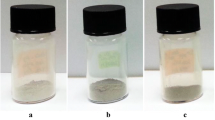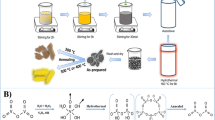Abstract
Powders composed of ZnO sub-microspheres were obtained in two stages: solvothermal synthesis and thermal annealing at 125, 300, 450 or 600ºC in atmospheric conditions. The synthesis was carried out with methanol as solvent, zinc acetate dihydrate as Zn2+ source and ammonia chloride as complexing agent. The as-grown and annealed samples were studied through photoluminescence, microRaman and reflectance spectroscopies, scanning electron microscopy and X-ray diffraction (XRD). After the solvothermal synthesis stage, a white precipitate was obtained composed of a flower-like multiphase assembly of layers identified mainly as a layered basic zinc salts (LBZS) and Zn(NH3)2Cl2. After the annealing treatments, the LBZS and Zn(NH3)2Cl2 transformed into ZnO, while the powder morphology changed from the layered flower-like to polycrystalline ZnO spherical particles with sub-micrometer diameters. With increasing annealing temperature, the ZnO spheres size remained unchanged, while the mean crystallite size and wurtzite lattice parameters decreased as a result of tensile stress relaxation. Concomitantly, a blueshift of the defect-related ZnO emission was observed. The combined analysis of emission, vibrational and reflectance spectra and XRD suggests that the annealing treatments result in the formation of ZnO crystallites with oxygen vacancies and oxygen vacancy-zinc interstitial complexes whose densities increase as the annealing temperature increases. The results and analysis reported in this work contribute to the understanding of growth mechanisms relevant for the tailoring of ZnO powder properties through solvothermal synthesis in non-aqueous media.









Similar content being viewed by others
References
C. Klingshirn, J. Fallert, H. Zhou, J. Sartor, C. Thiele, F. Maier-Flaig, D. Schneider, H. Kalt, 65 years of ZnO research—old and very recent results. Phys. Stat Solidi Basic Res. 247, 1424–1447 (2010). https://doi.org/10.1002/pssb.200983195
A.B. Djurisic, A.M.C. Ng, X.Y. Chen, ZnO nanostructures for optoelectronics: material properties and device applications. Prog. Quantum Electron. 34, 191–259 (2010). https://doi.org/10.1016/j.pquantelec.2010.04.001
O. Marin, V. González, M. Tirado, D. Comedi, Effects of methanol on morphology and photoluminescence in solvothermal grown ZnO powders and ZnO on Si. Mater. Lett. 251C, 41–44 (2019). https://doi.org/10.1016/j.matlet.2019.05.033
O. Marin, T. Soliz, J.A. Gutierrez, M. Tirado, C. Figueroa, D. Comedi, Structural, optical and vibrational properties of ZnO: M (M=Al3+ and Sr2+) nano and micropowders grown by hydrothermal synthesis. J. Alloys Compd. 789, 56–65 (2019). https://doi.org/10.1016/j.jallcom.2019.03.115
S.J. Pearton, D.P. Norton, M.P. Ivill, A.F. Hebard, J.M. Zavada, W.M. Chen, I.A. Buyanova, ZnO doped with transition metal ions. IEEE Trans. Electron Devices. 54, 1040–1048 (2007). https://doi.org/10.1109/TED.2007.894371
J. Neamtu, M. Volmer, The influence of doping with transition metal ions on the structure and magnetic properties of zinc oxide thin films. Sci. World J. 2014, 1–8 (2014). https://doi.org/10.1155/2014/265969
M. Rahman, M. Wei, F. Xie, M. Khan, Efficient dye-sensitized solar cells composed of nanostructural ZnO doped with Ti. Catalysts. 9, 273 (2019). https://doi.org/10.3390/catal9030273
A.M. Tayeb, M.A. Tony, E.K. Ismaeel, Engineered nanostructured ZnO for water remediation: operational parameters effect, Box-Behnken design optimization and kinetic determinations. Appl. Water Sci. (2019). https://doi.org/10.1007/s13201-019-0921-0
E. de Lucas-Gil, A. Del Campo, L. Pascual, M. Monte-Serrano, J. Menéndez, J.F. Fernández, F. Rubio-Marcos, The fight against multidrug-resistant organisms: the role of ZnO crystalline defects. Mater. Sci. Eng. C. 99, 575–581 (2019). https://doi.org/10.1016/j.msec.2019.02.004
A. Saranya, T. Devasena, H. Sivaram, R. Jayavel, Role of hexamine in ZnO morphologies at different growth temperature with potential application in dye sensitized solar cell. Mater. Sci. Semicond. Process. 92, 108 (2019). https://doi.org/10.1016/j.mssp.2018.03.028
Q. Zhang, G. Li, X. Liu, F. Qian, Y. Li, T.C. Sum, C.M. Lieber, Q. Xiong, A room temperature low-threshold ultraviolet plasmonic nanolaser. Nat. Commun. 5, 1–9 (2014). https://doi.org/10.1038/ncomms5953
J. Pan, J. Chen, Q. Huang, Q. Khan, X. Liu, Z. Tao, Z. Zhang, W. Lei, A. Nathan, Size Tunable ZnO nanoparticles to enhance electron injection in solution processed QLEDs. ACS Photonics. 3, 215–222 (2016). https://doi.org/10.1021/acsphotonics.5b00267
M.V. Bukhtiyarova, A review on effect of synthesis conditions on the formation of layered double hydroxides. J. Solid State Chem. 269, 494–506 (2019). https://doi.org/10.1016/j.jssc.2018.10.018
J. Demel, J. Hynek, P. Kovář, Y. Dai, C. Taviot-Guého, O. Demel, M. Pospíšil, K. Lang, Insight into the structure of layered zinc hydroxide salts intercalated with dodecyl sulfate anions. J. Phys. Chem. C. 118, 27131–27141 (2014). https://doi.org/10.1021/jp508499g
E. Hosono, S. Fujihara, T. Kimura, H. Imai, Growth of layered basic zinc acetate in methanolic solutions and its pyrolytic transformation into porous zinc oxide films. J. Colloid Interface Sci. 272, 391–398 (2004). https://doi.org/10.1016/j.jcis.2003.10.005
L. Tang, X. Ding, X. Zhao, Z. Wang, B. Zhou, Preparation of zinc oxide particles by using layered basic zinc acetate as a precursor. J. Alloys Compd. 544, 67–72 (2012). https://doi.org/10.1016/j.jallcom.2012.07.138
T. Yuki, S. Ueno, M. Hagiwara, S. Fujihara, Fabrication of layered hydroxide zinc nitrate films and their conversion to ZnO nanosheet assemblies for use in dye-sensitized solar cells. J. Asian Ceram. Soc. 3, 144–150 (2015). https://doi.org/10.1016/j.jascer.2014.12.006
L. Xue, X. Mei, W. Zhang, L. Yuan, X. Hu, Y. Huang, K. Yanagisawa, Synthesis and assembly of zinc hydroxide sulfate large flakes: application in gas sensor based on a novel surface mount technology. Sens Actuators, B Chem. 147, 495–501 (2010). https://doi.org/10.1016/j.snb.2010.03.016
F.C. Hawthorne, E. Sokolova, Simonkolleite, Zn5 (OH)8 Cl2 (H2O), a decorated interrupted-sheet structure of the form [MΦ2]4. Can. Mineral. 40, 939–946 (2002). https://doi.org/10.3749/gscanmin.40.3.939
E. Swanson, H.F. Mcmurdie, M.C. Morris, H. Evans, B. Paretzkin, Standard x-ray diffraction powder patterns. National Bureau of Standars Monograph 25, U.S. Department of Commerce (1972)
N.C. Vega, O. Marin, E. Tosi, G. Grinblat, E. Mosquera, M.S. Moreno, M. Tirado, D. Comedi, The shell effect on the room temperature photoluminescence from ZnO/MgO core/shell nanowires: exciton-phonon coupling and strain. Nanotechnology. 28, 275702 (2017). https://doi.org/10.1088/1361-6528/aa7454
J. He, J. Hu, X. Mo, Q. Hao, Z. Fan, G. He, Y. Wang, W. Li, Q. He, Novel photocatalyst nitrogen-doped simonkolleite Zn5(OH)8Cl2·H2O with vis-up-conversion photoluminescence and effective visible-light photocatalysis. Appl. Phys. A Mater. Sci. Process. (2019). https://doi.org/10.1007/s00339-018-2275-0
Y. Li, Y. Zou, Y. Hou, Synthesis and characterization of simonkolleite nanodisks and their conversion into ZnO nanostructures. Cryst. Res. Technol. 46, 305–308 (2011). https://doi.org/10.1002/crat.201000673
D.N. Ishikawa, C.A. Téllez, Infrared and Raman spectra of Zn(NH3)2Br 2 with 15N and 2H isotopic substitution. Vib Spectrosc 8, 87–95 (1994). https://doi.org/10.1016/0924-2031(94)00014-8
M.C. Bernard, A. Hugot-Le Goff, D. Massinon, N. Phillips, Underpaint corrosion of zinc-coated steel sheet studied by in situ raman spectroscopy. Corros. Sci. (1993). https://doi.org/10.1016/0010-938X(93)90356-L
H. Marchebois, S. Joiret, C. Savall, J. Bernard, S. Touzain, Characterization of zinc-rich powder coatings by EIS and Raman spectroscopy. Surf. Coatings Technol. 157, 151–161 (2002). https://doi.org/10.1016/S0257-8972(02)00147-0
N. Sangiorgi, L. Aversa, R. Tatti, R. Verucchi, A. Sanson, Spectrophotometric method for optical band gap and electronic transitions determination of semiconductor materials. Opt. Mater. (Amst) 64, 18–25 (2017). https://doi.org/10.1016/j.optmat.2016.11.014
T. Nakamura, T. Suemasu, K.I. Takakura, F. Hasegawa, A. Wakahara, M. Imai, Investigation of the energy band structure of orthorhombic BaSi2 by optical and electrical measurements and theoretical calculations. Appl. Phys. Lett. 81, 1032–1034 (2002). https://doi.org/10.1063/1.1498865
J. Rodríguez-Carvajal, Recent advances in magnetic structure determination by neutron powder diffraction. Phys. B Condens. Matter. 192, 55–69 (1993). https://doi.org/10.1016/0921-4526(93)90108-I
X. Xiao, B. Han, G. Chen, L. Wang, Y. Wang, Preparation and electrochemical performances of carbon sphere@ZnO core-shell nanocomposites for supercapacitor applications. Sci. Rep. 7, 1–13 (2017). https://doi.org/10.1038/srep40167
B.D. Cullity, S.R. Stock, Elements of—Ray Diffraction, 3rdrd edition edn. (Pearson Education Limited, Edinburgh, 2013)
P. Muhammed Shafi, A. Chandra Bose, Impact of crystalline defects and size on X-ray line broadening: a phenomenological approach for tetragonal SnO2 nanocrystals. AIP Adv. (2015). https://doi.org/10.1063/1.4921452
A. Khorsand Zak, W.H. Abd Majid, M.E. Abrishami, R. Yousefi, X-ray analysis of ZnO nanoparticles by Williamson-Hall and size-strain plot methods. Solid State Sci 13(2011), 251–256 (2011). https://doi.org/10.1016/j.solidstatesciences.2010.11.024
K. Manikandan, S. Dhanuskodi, A.R. Thomas, N. Maheswari, G. Muralidharan, D. Sastikumar, Size-strain distribution analysis of SnO2 nanoparticles and their multifunctional applications as fiber optic gas sensors, supercapacitors and optical limiters. RSC Adv. 6, 90559–90570 (2016). https://doi.org/10.1039/c6ra20503h
V. Russo, M. Ghidelli, P. Gondoni, C.S. Casari, A. Li Bassi, Multi-wavelength Raman scattering of nanostructured Al-doped zinc oxide. J. Appl. Phys. (2014). https://doi.org/10.1063/1.4866322
L. Bergman, X.B. Chen, J. Huso, J.L. Morrison, H. Hoeck, Raman scattering of polar modes of ZnO crystallites. J. Appl. Phys. (2005). https://doi.org/10.1063/1.2126784
C. Kranert, R. Schmidt-Grund, M. Grundmann, Surface- and point-defect-related Raman scattering in wurtzite semiconductors excited above the band gap. New J. Phys. (2013). https://doi.org/10.1088/1367-2630/15/11/113048
O. Marin, M. Tirado, N. Budini, E. Mosquera, C. Figueroa, D. Comedi, Photoluminescence from c-axis oriented ZnO films synthesized by sol-gel with diethanolamine as chelating agent. Mater. Sci. Semicond. Process. (2016). https://doi.org/10.1016/j.mssp.2016.07.007
H. Chen, J. Ding, W. Guo, G. Chen, S. Ma, Blue-green emission mechanism and spectral shift of Al-doped ZnO films related to defect levels. RSC Adv. 3, 12327 (2013). https://doi.org/10.1039/c3ra40750k
F. Kayaci, S. Vempati, I. Donmez, N. Biyikli, T. Uyar, Role of zinc interstitials and oxygen vacancies of ZnO in photocatalysis: a bottom-up approach to control the defect density. Nanoscale. 6, 10224–10234 (2014). https://doi.org/10.1039/C4NR01887G
D.H. Kim, G.W. Lee, Y.C. Kim, Interaction of zinc interstitial with oxygen vacancy in zinc oxide: an origin of n-type doping. Solid State Commun. 152, 1711–1714 (2012). https://doi.org/10.1016/j.ssc.2012.06.016
M. Asghar, K. Mahmood, I.T. Ferguson, M.Y.A. Raja, Y.H. Xie, R. Tsu, M.A. Hasan, Investigation of VO–Zni native donor complex in MBE grown bulk ZnO. Semicond. Sci. Technol. (2013). https://doi.org/10.1088/0268-1242/28/10/105019
V. Srikant, D.R. Clarke, On the optical band gap of zinc oxide. J. Appl. Phys. 83, 5447–5451 (1998). https://doi.org/10.1063/1.367375
I. Bouanane, A. Kabir, D. Boulainine, S. Zerkout, G. Schmerber, B. Boudjema, Characterization of ZnO thin films prepared by thermal oxidation of zn. J. Electron. Mater. 45, 3307–3313 (2016). https://doi.org/10.1007/s11664-016-4469-6
J. Husna, M. Mannir Aliyu, M. Aminul Islam, P. Chelvanathan, N. Radhwa Hamzah, M. Sharafat Hossain, M.R. Karim, N. Amin, Influence of annealing temperature on the properties of ZnO thin films grown by sputtering. Energy Procedia 25, 55–61 (2012). https://doi.org/10.1016/j.egypro.2012.07.008
P.J. Montoya-Pelaez, R.S. Brown, Methanolysis of nitrocefin catalyzed by one and two Zn2+ ions. a simplified model for class B β-lactamases. Inorg. Chem. 41, 309–316 (2002). https://doi.org/10.1021/ic011005f
E. Hosono, S. Fujihara, T. Kimura, H. Imai, Non-basic solution routes to prepare ZnO nanoparticles. J. Sol-Gel Sci. Technol. 29, 71–79 (2004). https://doi.org/10.1023/B:JSST.0000023008.14883.1e
M. Ardon, A. Bino, Hydrogen oxide bridging ligands in a classiscal coordination compound. J. Am. Chem. Soc. 105, 7747–7748 (1983)
H. Cao, Z. Zhang, L. Wu, G. Zheng, A novel approach of preparing ZnO from ammoniacal leaching solution with high chlorine levels based on thermodynamic analysis. Hydrometallurgy 171, 306–311 (2017). https://doi.org/10.1016/j.hydromet.2017.06.005
A. Babaei-dehkordi, J. Moghaddam, A. Mostafaei, An optimization study on the leaching of zinc cathode melting furnace slag in ammonium chloride by Taguchi design and synthesis of ZnO nanorods via precipitation methods. Mater. Res. Bull. 48, 4235–4247 (2013). https://doi.org/10.1016/j.materresbull.2013.06.077
A. Moezzi, M. Cortie, A. Mcdonagh, Transformation of zinc hydroxide chloride monohydrate to crystalline zinc oxide. Dalton Trans. 45, 7385–7390 (2016). https://doi.org/10.1039/c5dt04864h
H. Tanaka, A. Fujioka, Influence of thermal treatment on the structure and adsorption properties of layered zinc hydroxychloride. Mater. Res. Bull. 45, 46–51 (2010). https://doi.org/10.1016/j.materresbull.2009.09.003
Acknowledgements
This research was supported by SCAIT-UNT (PIUNT E637), CONICET (PIP 411) and ANPCyT (FONCyT–BID PICT 2015-0865). We are grateful to Lic. Dolly Chemes and the LERA facility (CONICET–UNT) for enabling the microRaman measurements.
Author information
Authors and Affiliations
Corresponding authors
Ethics declarations
Conflict of interest
The authors declare that they have no conflict of interest.
Additional information
Publisher's Note
Springer Nature remains neutral with regard to jurisdictional claims in published maps and institutional affiliations.
Electronic supplementary material
Below is the link to the electronic supplementary material.
Rights and permissions
About this article
Cite this article
Marin, O., González, V., Budini, N. et al. The influence of methanol and NH4Cl on solvothermal ZnO synthesis and properties. Appl. Phys. A 126, 466 (2020). https://doi.org/10.1007/s00339-020-03636-w
Received:
Accepted:
Published:
DOI: https://doi.org/10.1007/s00339-020-03636-w




